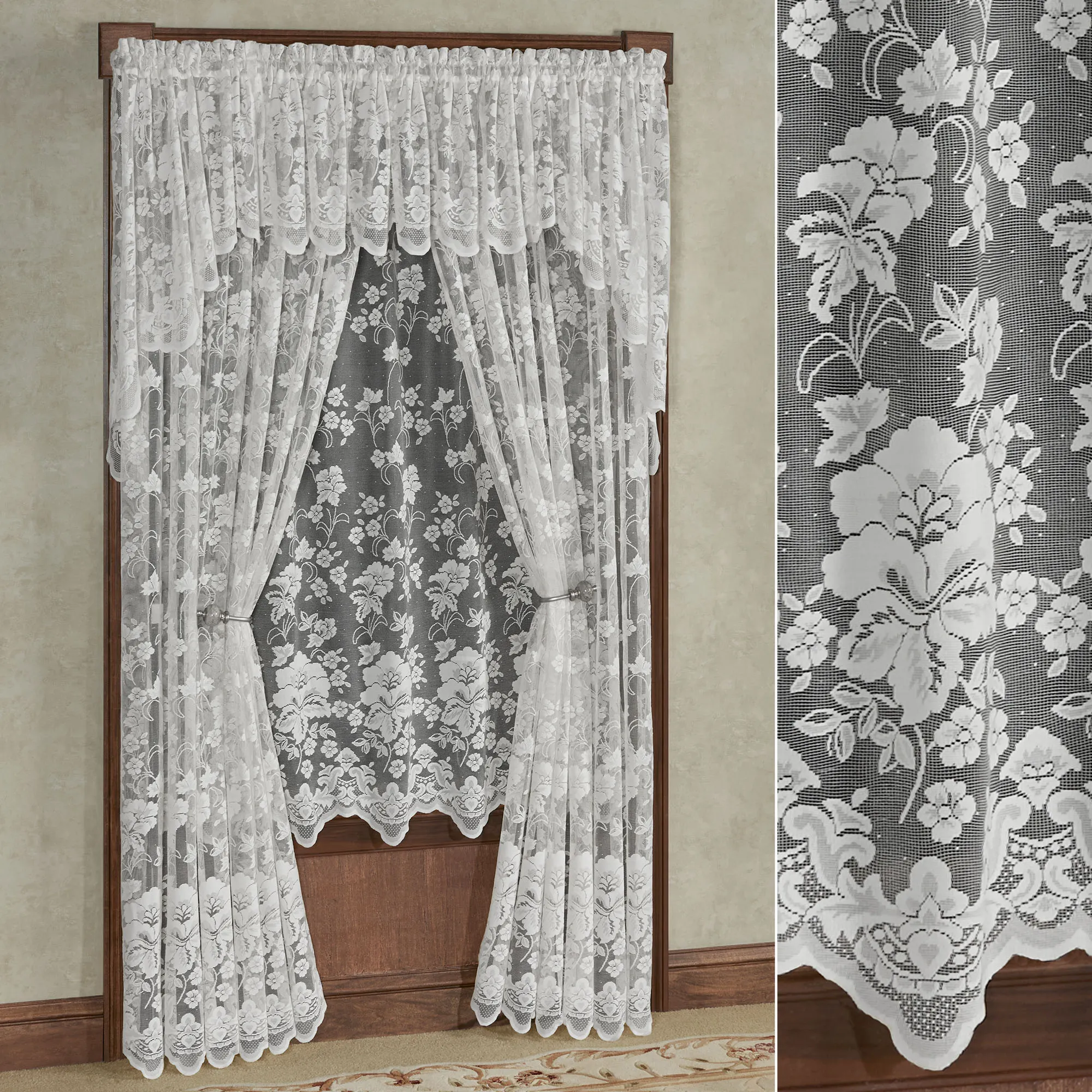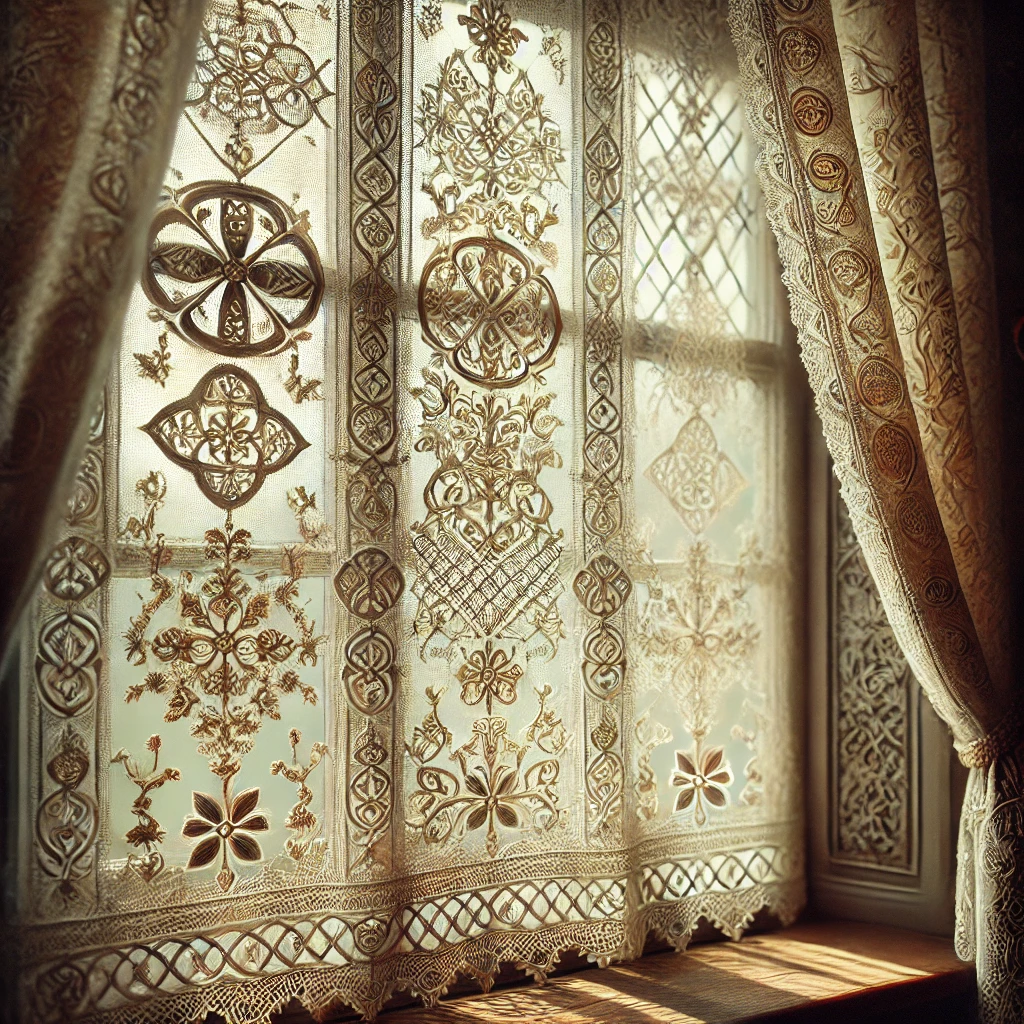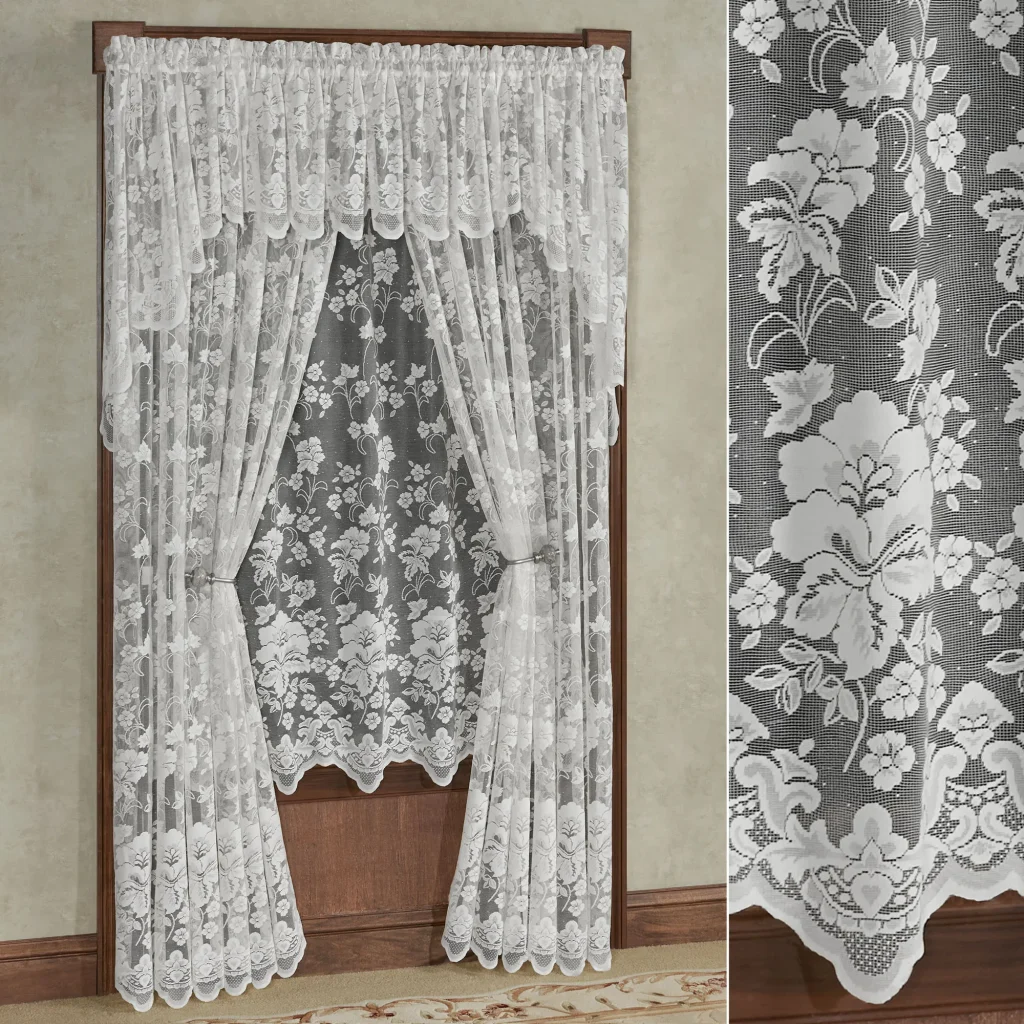
There are words that cut through bone, words that slice deep, leaving invisible scars that last generations.
And then there are words that slide in soft, like lace against skin, masking the blade hidden beneath.
Lace Curtain Irish.
At first glance, it sounds elegant, refined, even poetic. Lace—delicate, intricate, the kind of thing that belongs in the window of a well-kept home, gently billowing in the afternoon light. But lace curtains weren’t just fabric in an Irish household. They were a barrier. A veil between the hardscrabble past and the desperate attempt at a respectable future.
Because to be Lace Curtain Irish was not just to own lace curtains. It was to exist on the edge of an identity crisis—a place between Shanty Irish and true Anglo respectability, where every carefully pressed suit, every stiff-backed church pew, every polished word was an act of defiance against the past.
And in America, that past was as brutal as it was unforgettable.
Lace Curtain Irish vs. Shanty Irish: The Dividing Line

The Irish who came to America didn’t all step off the boat the same way. Some carried dreams, others carried nothing but famine-hollowed eyes and the filth of steerage class. And from the moment they arrived, they were divided.
- Shanty Irish – The poor, rough, tenement-dwelling Irish who worked on the docks, in the mills, in the mines. They drank, they fought, they worked until their hands bled. They were proud of their rough edges because they had no choice but to wear them like armor.
- Lace Curtain Irish – The upwardly mobile Irish, those who had clawed their way out of the slums and into homes with lace curtains in the windows. They shunned their working-class roots, often mimicking the customs of the Anglo-Protestant elite in an attempt to be accepted.
This division was a lifelong war—one fought not with fists, but with disdain, judgment, and whispers over Sunday roast dinners.
Difference Between Lace Curtain Irish and Shanty Irish Joke
The old joke summed it up perfectly:
- Shanty Irish put their feet on the table and eat with their hands.
- Lace Curtain Irish use the silverware, but they still steal the spoons.
It was a dig—both at the desperate aspiration of the Lace Curtain Irish and at the stubborn, unshakable rawness of the Shanty Irish. Because in America, no matter how many lace curtains you hung, you were still Irish. And that meant you were still, in the eyes of those in power, one step away from being nothing at all.
Lace Curtain Irish: Law and Order, Catholic Morality, and the Fight for Acceptance
One of the defining features of the Lace Curtain Irish was their obsession with law, order, and morality. While the Shanty Irish might have been the ones running the gambling dens, fighting bare-knuckle in the streets, and organizing labor strikes, the Lace Curtain Irish were the ones joining the police force, sitting in city government, and enforcing the very laws their ancestors had once broken.
They became judges, lawyers, and clergy, desperate to distance themselves from the criminality and lawlessness that had plagued their immigrant roots.
But behind the lace curtains, the struggles remained the same. The desperation for acceptance. The fear of falling back into poverty. The gnawing suspicion that no matter how well you dressed, how well you spoke, how many times you went to Sunday Mass… you would still never truly belong.
And nowhere was this struggle more vividly depicted than in The Departed.
Lace-Curtain Irish in The Departed
Martin Scorsese’s The Departed doesn’t just tell a story about crime and corruption—it tells a story about class, identity, and the Irish-American experience.
- Colin Sullivan (Matt Damon) is the embodiment of Lace Curtain Irish—well-dressed, educated, a man who has risen in status but is still secretly working for the very criminals he tries to distance himself from.
- Billy Costigan (Leonardo DiCaprio) is the Shanty Irish—from a family of criminals, rejected from polite society, but possessing a raw authenticity that Sullivan will never have.
One wears lace curtains, the other wears his scars. And in the end, the world of power and respectability devours them both.
The Irish in St. Louis: From Shanty to Lace Curtain
Nowhere was this transformation more evident than in cities like St. Louis, where Irish immigrants went from being impoverished dock workers and laborers to powerful figures in city politics and business.
The Lace Curtain Irish in St. Louis built churches, schools, and political machines, creating a world where their children could rise above the Shanty Irish roots that had once defined them.
They fought their way into law enforcement, education, and even business, creating a respectable Irish middle class—but always with the shadow of their past lurking behind those lace curtains.
Where Did Lace Curtains Come From?
Lace itself has a long history, but lace curtains became a symbol of middle-class respectability in the 19th century. They were a way to show that a home was clean, proper, and aspirational—the very things that the Lace Curtain Irish desperately wanted to be.
Owning lace curtains meant you had made it—or at least, that you wanted people to think you had.
And even today, you can still find Lace Curtain Irish for sale online, as a reminder of that era—both a decoration and a silent symbol of a battle fought behind closed doors.
FAQs: Understanding Lace Curtain Irish and Irish Culture
What does the term “lace curtain” in Irish mean?
It refers to the upwardly mobile Irish, those who sought respectability and tried to distance themselves from their working-class Shanty Irish roots.
What is the Irish lace tradition?
Irish lace is a delicate, handcrafted textile that became world-famous in the 19th century. It was created by Irish women as a way to earn money during hard times, and it remains a prized craft today.
What does it mean to be lace curtain?
To be lace curtain means to be aspirational, trying to blend into upper-class society while still carrying the baggage of working-class roots.
What is the Irish in St. Louis from shanty to lace curtain?
It refers to the journey of Irish immigrants in St. Louis, who started as poor laborers but eventually rose to middle-class respectability, particularly in politics and law enforcement.
Where did lace curtains come from?
They originated in Europe as a sign of wealth and later became symbols of middle-class respectability in Ireland and America.
What does “frock” mean in Irish?
In Irish slang, a frock is a dress—but historically, it could also refer to a priest’s robe.
What are the three types of Irish?
- Gaelic Irish – The native Irish who held onto their language and traditions.
- Anglo-Irish – Descendants of English settlers in Ireland.
- Irish-American (or Diaspora Irish) – Those who emigrated and shaped the Irish identity abroad.
What is the name of Irish lace?
The most famous type of Irish lace is Carrickmacross lace, known for its intricate patterns and fine craftsmanship.
The Battle Behind the Curtains
The Lace Curtain Irish weren’t just about class—they were about survival. About the constant fight to be accepted, respected, and never seen as “just Irish.”
But in the end, lace curtains are just that—curtains. A barrier between who we are and who we pretend to be. And no matter how many we hang in our windows, the past still lingers just beyond the glass.
For more on Irish culture, history, and identity, visit:
Sláinte! 🍀
Lace curtains were never just fabric. They were a performance, a statement, a desperate bid for belonging. The Lace Curtain Irish knew that in America, image was everything. You could still be Irish, but you had to be the right kind of Irish—the kind that dressed well, spoke softly, and made sure the neighbors saw the lace in the windows and not the whiskey in the cabinet.
The battle for respectability wasn’t just about class—it was about survival. The Shanty Irish scraped by on sweat and struggle, but the Lace Curtain Irish fought with a different weapon: appearances. They went to Mass in polished shoes, joined fraternal organizations, and married into families that would elevate their standing. They believed in law and order, not because they were inherently conservative, but because they knew that the only way to be accepted was to be beyond reproach.
This wasn’t just an American phenomenon. In Ireland, where British landlords had long dictated the rules of society, the Irish had learned to navigate a world in which survival depended on blending in. The Lace Curtain Irish took that lesson to heart. In the tenement neighborhoods of Boston, New York, Chicago, and St. Louis, they crafted identities out of caution and calculated ambition.
But the world of the Lace Curtain Irish wasn’t without contradictions. They wanted to move beyond the dirt-floor cabins and coal-dusted hands of their ancestors, yet they still feared becoming too much like the Anglo elites who had once looked down on them. They criticized the Shanty Irish for their rough ways, but they never fully forgot the bloodline they shared. It was a fragile balancing act, and one that never truly ended.
The Unspoken Rules of the Lace Curtain Irish
There were unwritten rules to being Lace Curtain Irish. The first was knowing when to abandon the things that marked you as too Irish. The brogue, if you had one, had to be softened or erased entirely. Gaelic was for the old folks, not for those trying to make it in an English-speaking world. The second rule was about presentation—lace curtains in the windows, yes, but also a clean, well-kept home, free of the disorder associated with the chaotic, overcrowded tenements.
Education was essential. Where the Shanty Irish might take pride in hard labor, the Lace Curtain Irish sent their children to Catholic schools, later to universities, and eventually into professions that carried prestige—law, medicine, politics. The priesthood was also a respected path, a way to elevate a family’s standing while maintaining a moral high ground.
Politics was another avenue of ascent. The Irish in America had been shut out of power for so long that they learned to build their own political machines. The Shanty Irish filled the ranks, but the Lace Curtain Irish were the ones who ran the show—mayors, judges, congressmen. They kept one foot in the world of the working class, but the other was planted firmly in the halls of power.
Lace Curtain Irish in Pop Culture
The struggle of the Lace Curtain Irish has been woven into the fabric of American cinema and literature. In The Departed, Matt Damon’s character, Colin Sullivan, is the epitome of the Lace Curtain Irish—well-groomed, educated, outwardly respectable, yet still tied to the underworld he desperately tries to hide. Leonardo DiCaprio’s Billy Costigan, on the other hand, represents the Shanty Irish—rough around the edges, from a criminal family, but ultimately more honest in his identity.
Another example comes from the classic Irish-American gangster films. In The Godfather, though the Corleones are Italian, the dynamics are familiar—those who want to assimilate, to erase their ethnic identity in favor of American success, versus those who refuse to let go of their roots, even at a cost.
In Gangs of New York, we see the early days of the Irish struggle in America, when the distinction between Shanty and Lace Curtain Irish was just beginning to form. The rough immigrants of the Five Points fought in the streets, while those who rose above them sought positions in politics, law enforcement, and business.
The Rise and Fall of the Lace Curtain Irish
The height of the Lace Curtain Irish era was the late 19th and early 20th centuries, when the Irish were still fighting to carve out a place in American society. But by the mid-to-late 20th century, their influence began to wane.
As the Irish became more integrated into mainstream American life, the distinction between Shanty and Lace Curtain Irish faded. The children and grandchildren of these immigrants had moved into the suburbs, taking their lace curtains with them. They had married outside of their ethnic group, lost the brogues entirely, and entered the American middle class. The fight for respectability had been won—but at a cost.
Some say that in winning acceptance, the Lace Curtain Irish lost something else. They had fought so hard to be seen as proper, respectable, and above reproach that they sometimes became disconnected from their own heritage. The raw, untamed Irish spirit—the rebelliousness, the storytelling, the fire—was softened. Some even came to look down on the very things that had once defined them.
Yet, echoes of the old divisions still remain. In certain circles, calling someone Lace Curtain Irish can still carry a hint of derision, a suggestion that they’ve forgotten where they came from. In others, it’s a badge of honor, a mark of having risen above the struggles of the past.
The Enduring Legacy of the Lace Curtain Irish
The legacy of the Lace Curtain Irish lives on in many ways. It’s in the police forces and courtrooms where Irish surnames still dominate. It’s in the Catholic schools and universities that Irish immigrants built as a way to secure a better future for their children. It’s in the law offices and political dynasties that trace their roots back to tenement neighborhoods where lace curtains first appeared in the windows.
And it’s in the quiet moments of reflection, when a second- or third-generation Irish-American looks at an old family photograph and wonders what their ancestors would think of them now. Would they be proud? Would they see their sacrifices as worth it? Or would they shake their heads at how far their descendants have drifted from the fight?
Lace curtains may no longer be the symbol they once were, but the struggle they represented—the eternal balancing act between past and future, between tradition and assimilation—remains as relevant as ever.
FAQS
What does the term “lace curtain” in Irish mean?
Lace Curtain Irish refers to Irish immigrants and their descendants who moved up the social ladder, distinguishing themselves from their poorer, working-class counterparts, the Shanty Irish.
What is the Irish lace tradition?
Irish lace is a highly detailed, handmade textile tradition that became famous in the 19th century. It was often used to create decorative curtains, tablecloths, and garments.
What does it mean to be lace curtain?
To be lace curtain means to aspire to middle-class or upper-class respectability, often at the expense of working-class Irish roots.
What is the Irish in St. Louis from shanty to lace curtain?
It refers to the journey of Irish immigrants in St. Louis, who transitioned from working-class, tenement-dwelling laborers (Shanty Irish) to more socially respected, middle-class citizens (Lace Curtain Irish).
Where did lace curtains come from?
Lace curtains originated in Europe and became a symbol of middle-class respectability in Ireland and among Irish immigrants in America.
What does “frock” mean in Irish?
In Irish slang, “frock” refers to a dress, but historically, it could also refer to a priest’s robe.
What are the three types of Irish?
- Gaelic Irish – Native Irish who maintained their language and traditions.
- Anglo-Irish – Descendants of English settlers in Ireland.
- Irish-American (or Irish Diaspora) – Those who emigrated and shaped Irish identity abroad.
What is the name of Irish lace?
Carrickmacross lace is one of the most famous types of Irish lace, known for its delicate, handcrafted patterns.





2 thoughts on “Lace Curtain Irish: A Story of Class, Identity, and the Struggle for Respectability”
Comments are closed.